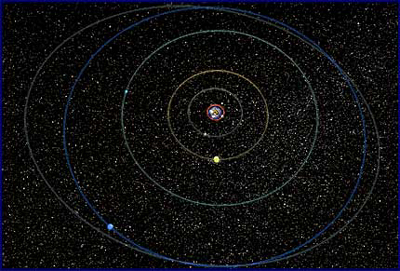
14) The Quran on the Sun and the Moon's Orbit:
The information the Quran provides on this subject mainly deals with the solar system. References are however made to phenomena that go beyond the solar system itself: they have been discovered in recent times.
There are two very important verses on the orbits of the Sun and Moon:
Sura 21, verse 33:
"(God is) the One Who created the night, the day, the sun and the moon. Each one travelling in an orbit with its own motion."
Sura 36, verse 40:
"The sun must not catch up the moon, nor does the night outstrip the day. Each one is travelling in an orbit with its own motion."

Here, an essential fact is clearly stated: the existence of the Sun's and Moon's orbits, plus a reference is made to the travelling of these bodies in space in their own motion.
A negative fact also emerges from a reading of these verses: it is shown that the Sun moves in an orbit, but no indication is given as to what this orbit might be in relation to the Earth. At the time of the Quranic Revelation, it was thought that the Sun moved while the Earth stood still. This was the system of geocentrism that had held sway since the time of Ptolemy, Second century B.C., and was to continue to do so until Copernicus in the Sixteenth century A.D. Although people supported this concept at the time of Mohammed, it does not appear anywhere in the Quran, either here or elsewhere.
The Arabic word falak has here been translated by the word 'orbit'; many translators of the Quran attach to it the meaning of 'sphere'. This is indeed its initial sense.
The Moon's Orbit
Today, the concept is widely spread that the Moon is a satellite of the Earth around which it revolves in periods of twenty-nine days. A correction must however be made to the absolutely circular form of its orbit, since modern astronomy ascribes a certain eccentricity to this, so that the distance between the Earth and the Moon (240,000 miles) is only the average distance.
We see in the following verse how the Quran underlined the usefulness of observing the Moon's movements in calculating time, Sura 10, verse 5:
"God is the One Who made the sun a shining glory and the moon a light and for her ordained mansions, so that you might know the number of years and the reckoning (of time). God created this in truth. He explains the signs in detail for people who know."
The Sun.
It is more difficult to conceive of the Sun's orbit because we are so used to seeing our solar system organized around it. To understand the verse from the Quran, the position of the Sun in our galaxy must be considered, and we must therefore call on modern scientific ideas.
Our galaxy includes a very large number of stars spaced so as to form a disc that is denser at the center than at the rim. The Sun occupies a position in it which is far removed from the center of the disc. The galaxy revolves around its own axis which is its center with the result that the Sun revolves around the same center in a circular orbit. Modern astronomy has worked out the details of this. In 1917, Shapely estimated the distance between the Sun and the center of our galaxy at 10 kiloparsecs i.e., in miles, circa the figure 2 followed by 17 zeros. To complete one revolution on its own axis, the galaxy and Sun take roughly 250 million years. The Sun travels at roughly 150 miles per second in the completion of this.
The above is the orbital movement of the Sun that was already referred to by the Quran fourteen centuries ago. The demonstration of the existence and details of this is one of the achievements of modern astronomy.
Next: The Quran on the Sequence of Day and Night